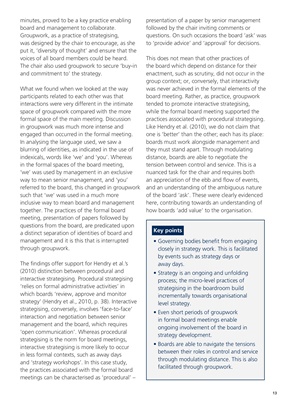
13
minutes, proved to be a key practice enabling
board and management to collaborate.
Groupwork, as a practice of strategising,
was designed by the chair to encourage, as she
put it, 'diversity of thought' and ensure that the
voices of all board members could be heard.
The chair also used groupwork to secure 'buy-in
and commitment to' the strategy.
What we found when we looked at the way
participants related to each other was that
interactions were very different in the intimate
space of groupwork compared with the more
formal space of the main meeting. Discussion
in groupwork was much more intense and
engaged than occurred in the formal meeting.
In analysing the language used, we saw a
blurring of identities, as indicated in the use of
indexicals, words like 'we' and 'you'. Whereas
in the formal spaces of the board meeting,
'we' was used by management in an exclusive
way to mean senior management, and 'you'
referred to the board, this changed in groupwork
such that 'we' was used in a much more
inclusive way to mean board and management
together. The practices of the formal board
meeting, presentation of papers followed by
questions from the board, are predicated upon
a distinct separation of identities of board and
management and it is this that is interrupted
through groupwork.
The findings offer support for Hendry et al.'s
(2010) distinction between procedural and
interactive strategising. Procedural strategising
'relies on formal administrative activities' in
which boards 'review, approve and monitor
strategy' (Hendry et al., 2010, p. 38). Interactive
strategising, conversely, involves 'face-to-face'
interaction and negotiation between senior
management and the board, which requires
'open communication'. Whereas procedural
strategising is the norm for board meetings,
interactive strategising is more likely to occur
in less formal contexts, such as away days
and 'strategy workshops'. In this case study,
the practices associated with the formal board
meetings can be characterised as 'procedural' -
presentation of a paper by senior management
followed by the chair inviting comments or
questions. On such occasions the board 'ask' was
to 'provide advice' and 'approval' for decisions.
This does not mean that other practices of
the board which depend on distance for their
enactment, such as scrutiny, did not occur in the
group context; or, conversely, that interactivity
was never achieved in the formal elements of the
board meeting. Rather, as practice, groupwork
tended to promote interactive strategising,
while the formal board meeting supported the
practices associated with procedural strategising.
Like Hendry et al. (2010), we do not claim that
one is 'better' than the other; each has its place:
boards must work alongside management and
they must stand apart. Through modulating
distance, boards are able to negotiate the
tension between control and service. This is a
nuanced task for the chair and requires both
an appreciation of the ebb and flow of events,
and an understanding of the ambiguous nature
of the board 'ask'. These were clearly evidenced
here, contributing towards an understanding of
how boards 'add value' to the organisation.
• Governing bodies benefit from engaging
closely in strategy work. This is facilitated
by events such as strategy days or
away days.
• Strategy is an ongoing and unfolding
process; the micro-level practices of
strategising in the boardroom build
incrementally towards organisational
level strategy.
• Even short periods of groupwork
in formal board meetings enable
ongoing involvement of the board in
strategy development.
• Boards are able to navigate the tensions
between their roles in control and service
through modulating distance. This is also
facilitated through groupwork.
Key points